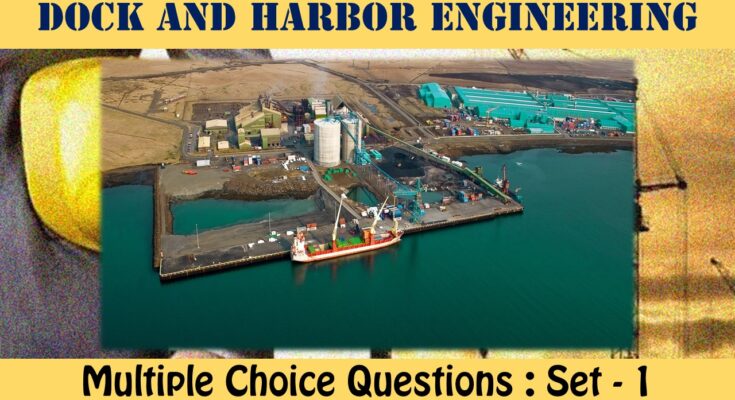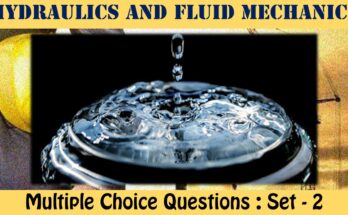MCQ Questions Civil Engineering Design of Masonry Structures
The interviewer is almost as nervous as the candidate in most interviews. You might wonder if you look confident enough, if you will hire the right person, or if you are asking the right engineering interview questions. The last question is arguably the most crucial part to worry about when you’re interviewing candidates. Other topics on Civil Engineering Multiple Choice Questions can be accessed
MCQ Questions Civil Engineering Docks And Harbour Engineering - Set - 1
Question 1:
Consider the following statements in regard to Beaufort scale for wind speeds,
(i) The Beaufort number ranges from 1 to 12.
(ii) Higher Beaufort number indicates higher speed of wind,
(iii) Beaufort number for calm is smallest and for hurricane is highest Of these statements
a) (i) and (ii) are correct
b) (ii) and (iii) are correct
c) (i) and (iii) are correct
d) (i), (ii) and (iii) are correct
Correct Answer – (B)
Question 2 :
As per Berlin’s formula, the length of wave in metres is given by
a) 1.3412
b) 1.5612
c) 1.7412
d) 1.9412
where ‘t’ is the period in seconds for two successive waves to pass the same section.
Correct Answer – (B)
Question 3 :
In basins subjected to strong winds and tide, the length of the berthing area should not be less than
a) the length of design vessel
b) the length of design vessel + 10% clearance between adjacent vessels
c) the length of design vessel + 20% clearance between adjacent vessels
d) twice the length of design vessel
Correct Answer – (C)
Question 4 :
The minimum diameter of turning besin, where ships turn by going ahead and without tug assistance should be
a) L
b) 1.5 L
c) 2.0 L
d) 4.0 L
where L is the length of the largest ship to use the port
Correct Answer – (D)
Question 5 :
When a ship floats at its designed water line, the vertical distance from water line to the bottom of the ship is known as
a) beam
b) depth
c) freeboard
d) draft
Correct Answer – (D)
MCQ Questions Civil Engineering Docks And Harbour Engineering
Question 6:
Assertion A : Intervention of undulations in the sea bed reduces the depth of wave at the section.
Reason R : No wave can have a height greater than the depth of water through which it passes.
Select your answer based on the coding system given below:
a) Both A and R are true and R is correct explanation of A.
b) Both A and R are true but R is not the correct explanation of A.
c) A is true but R is false.
d) A is false but R is true.
Correct Answer – (A)
Question 7:
As per Stevenson’s empirical formula, the approximate value of the height of the wave in metres is given by
a) 0.34 VF
b) 0.5 VF
c) 1.5 VF
d) 3.4 VF
where F is the fetch in km.
Correct Answer – (A)
Question 8:
Dead weight tonnage of a ship
i) varies with latitude and season
ii) is more than displacement tonnage
iii) is the difference between displacement load and displacement light Of these statements
a) i) and ii) are correct
b) ii) and iii) are correct
c) i) and iii) are correct
d) Only iii) is correct
Correct Answer – (C)
Question 9:
The maximum harbour depth below lowest low water is generally equal to
(i) loaded draft + 1.2 m when bottom is rock
(ii) loaded draft + 1.8 m when bottom is soft
(iii) loaded draft + 1.2 m when bottom is soft
(iv) loaded draft + 1.8 m when bottom is rock
Of these statements
a) (i) and (ii) are correct
b) (i) and (iii) are correct
c) (ii) and (iv) are correct
d) (iii) and (iv) are correct
Correct Answer – (D)
Question 10:
Assertion A : Depth and width required at the entrance to a harbour are more than those required in the channel.
Reason R : The entrance to a harbour is usually more exposed to waves as compared to the harbour itself.
Select your answer based on the coding system given below:
a) Both A and R are true and R is the correct explanation of A.
b) Both A and R are true but R is not the correct explanation of A.
c) A is true but R is false.
d) A is false but R is true.
Correct Answer – (A)
- NCERT Solutions Class 12 Mathematics RD Sharma Sets : Exercise 1.1
- NCERT Solutions Class 12 Mathematics RD Sharma Sets : Exercise 1.2
- NCERT Solutions Class 12 Mathematics RD Sharma Sets : Exercise 1.3
- NCERT Solutions Class 12 Mathematics RD Sharma Sets : Exercise 1.4
- NCERT Solutions Class 12 Mathematics RD Sharma Trigonometric Functions : Exercise – 5.1
- NCERT Solutions Class 12 Mathematics RD Sharma Trigonometric Functions : Exercise – 5.2
- NCERT Solutions Class 12 Mathematics RD Sharma Trigonometric Functions : Exercise – 5.3
- NCERT Solutions Class 12 Mathematics RD Sharma Quadratic Equations : Exercise – 14.1
- NCERT Solutions Class 12 Mathematics RD Sharma Quadratic Equations : Exercise – 14.2
- NCERT Solutions Class 12 Mathematics RD Sharma Linear Inequations : Exercise – 15.1
- NCERT Solutions Class 12 Mathematics RD Sharma Linear Inequations : Exercise – 15.2
- NCERT Solutions Class 12 Mathematics RD Sharma Linear Inequations : Exercise – 15.3
- NCERT Solutions Class 12 Mathematics RD Sharma Linear Inequations : Exercise – 15.4
- NCERT Solutions Class 12 Mathematics RD Sharma Linear Inequations : Exercise – 15.5
- NCERT Solutions Class 12 Mathematics RD Sharma Linear Inequations : Exercise – 15.6
Multiple Choice Questions for Competitive Exams
- Multiple Choice Questions Class 12 Chemistry The Solid State
Set -1 Set -2 Set -3 Set -4 Set -5 - MCQ Questions Class 12 Solutions With Answers
Set -1 Set -2 Set -3 Set -4 Set -5 - MCQ Questions Class 12 Electrochemistry With Answers
Set -1 Set -2 Set -3 Set -4 Set -5 - MCQ Questions Class 12 Chemical Kinetics With Answers
Set -1 Set -2 Set -3 Set -4 Set -5 - MCQ Questions Class 12 Surface Chemistry With Answers
Set -1 Set -2 Set -3 Set -4 Set -5 - MCQ Questions Class 12 General Principles and Processes of Isolation of Elements With Answers
Set -1 Set -2 Set -3 Set -4 Set -5




